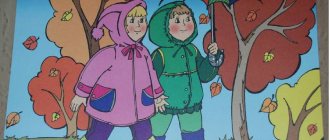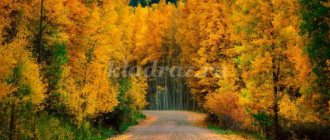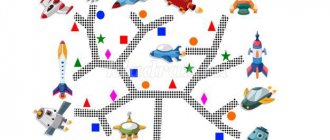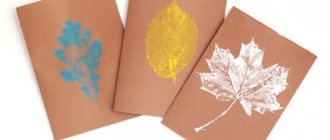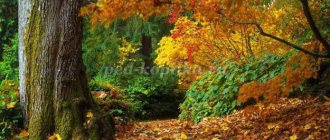Lesson summary “Golden Autumn”
Theme of the week “Golden Autumn” Familiarization with the world around us 1. Children should know: *names of the autumn months, the main signs of autumn;
*changes that occur in autumn in the flora and fauna; *what people do in the fall, how they dress; *distinctive features of early and late autumn. 2. Children should be able to: *generalize, compare signs, specify concepts, highlight the main signs of autumn, analyze phenomena, use existing knowledge about autumn in solving problems, performing exercises, assignments; *be interested in the phenomena of living and inanimate nature; *be able to establish cause-and-effect relationships (changes in living and inanimate nature and changes in external conditions: the gradual extinction of plant life is caused by cold weather; the departure of birds is associated with the disappearance of insects and the freezing of water bodies). 3. Game “Before-between-for”. Consolidating ideas about the seasons, an exercise in time orientation. (What time of year will come before autumn, after autumn, between summer and winter (autumn), between winter and summer (spring), etc.) 4. Game “Echo”. Practice the formation of complex words using the method of adding stems. Leaves are falling. - This is leaf fall. The stars are falling. - This is a meteor shower. The water is falling. - This is a waterfall. Stones are falling. - It's a rockfall. It's snowing. - It's snowing. 5. Game “I’ll start, and you finish” People in the fall are dressed (in what?) -...; schoolchildren go with their briefcases (where?) - ...; the leaves on the trees have become (what?) - ...; flowers in the flower beds (what did they do?) - ...; birds fly away (where?) - ...; animals do for the winter (what?) - ...; people collect in forests, gardens, fields and vegetable gardens (what?) - ... . 6. Compose a descriptive story on the topic “What clothes do we wear in the fall” according to plan: a) Why do we dress warmer in the fall than in the summer? b) What do we wear on our feet (in dry weather and in rain)? c) What do we put on the body? d) What do we wear on our heads, necks, hands? d) When do we take an umbrella with us? Speech development 1. Dictionary. Nouns: autumn, cloud, rain, weather, leaf fall, dirt, earth, dampness, jacket, raincoat, boots, hat, gloves, sweater, umbrella, September, October, November. Verbs: pour, blow, step on, wither, drizzle. To wilt, frown, sprinkle. Adjectives: Cold, wet, gloomy, autumnal, oblique, dull, cloudy. Golden (autumn), gray (days), chilly, pouring, drizzling. Adverbs: Wet, damp, stormy, cloudy. 2. Game “Say otherwise.” An exercise in selecting synonyms. A dull time - dull, sad, dreary, gloomy, sad. The sky is gray - dark, cold, cloudy. Trees are naked - naked, naked (without leaves). The flowers dried up and withered. 3. Game “Say the opposite”. Search for antonyms. Early autumn - late autumn. A happy day is a sad day. Sunny day - cloudy day. White cloud - black cloud. 4.Form high-quality adjectives. Autumn - autumn; November – November; sun - sunny; September – September; rain - rainy; cold - cold; October - … ; cloud - … ; warm - … . 5. Select actions (what does it do?). Rain - dripping, pouring, drizzling, coming... . The wind blows, blows, blows, breaks.... 6. Game “One - many”. Formation of the plural of verbs, nouns and adjectives (say according to the example). An autumn day has come - autumn days have come; there is a yellow leaf on the tree - there are yellow leaves on the trees; a dark cloud is floating - dark clouds are floating; there is a big tree - there are big trees; it's cold raining - it's raining coldly; a strong wind blows - heavy rains blow; a warm jacket is hanging - warm jackets are hanging; a flock of birds is flying - flocks of birds are flying. Learning to read and write Topic “Vowel sound O, letter O” 1. Determine by ear the place of the sound in words: wasps, catfish, popsicle, mustache (there is no O sound). 2.Remember the difference between a sound and a letter. We pronounce sounds and write letters. 3.Analysis of the letter O. What object does this letter resemble? There is no angle in this letter, that is why it is round. Look at the wheel - And you will see the letter O. 4. Write this letter in the air. 5. Riddle It grows on the bushes in the garden, The smell is sweet, like honey, But often the tears flow Those who tear with their hands... (Roses) You can tell the child a little about the rose. (The rose is called the queen of flowers. It is the most fragrant and the most beautiful.) *How can you say about a rose? The child himself gives definitions and synonyms. For example: beautiful, wonderful, charming, magnificent, etc. Then comes the analysis of this word, division into syllables (orally). Let's draw a diagram: 6. Phonetic game “Who is more attentive?” Didactic task. Develop phonemic awareness; to develop the ability to hear the sound O in words. The child, after listening to the tongue twister: That’s why Sovronya was given a snout, so that she could dig the earth, counts and names words with the sound O. Remember and name as many words as possible. Option. The child can be offered words with the sound O in different positions - not only at the beginning of the word. (For example: windows, boots, cinema, etc.) 7. Game “Catch the sound “O”” (clap your hands) *Isolating sound: -from the sound series: o, a, u, i, o, i, a, o, a, y, o, i, e, etc.; -from the syllabic series: at, from, op, un, ik, ok, etc.; -from a number of words: fence, cabbage, vegetable, tail, old man, cat, rooster, glass, toad, beetle, taxi, cake, etc. FEMP 1. Reinforce the composition of the number 6, graphically depict the number 6. 2. Develop logical thinking and spatial imagination. 3.Practice in solving problems, identifying parts in a problem. 4. Game exercises: “Whoever knows, let him continue” (goal: practice counting within 10 in forward and reverse order), “Name the neighbors of the number.” 5. Consolidating the composition of the number 6 (3da3; 5da1; 4da2; 2da4; 1 and 1, da1, da1, da1; da1). 6.Working with a number segment. 7.Work on the sheet “Continue the pattern.” (For example, a circle, square, triangle, circle, square is drawn on a sheet of paper. The child must then continue the drawing itself to the end of the line)
